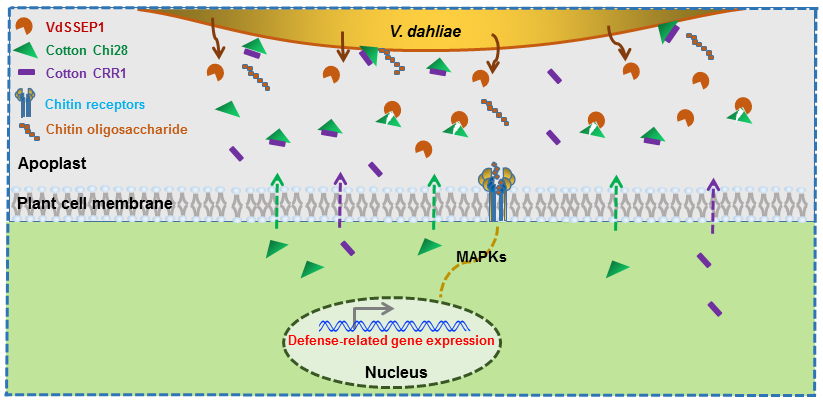Progress in the study of interaction between cotton and Verticillium dahliae
Press release – translated from the original Article source: Microbiology Research Institute Published: 2019-01-23
Cotton Verticillium wilt is a soil-transmitted vascular bundle disease caused by Verticillium dahliae, which is the primary disease that restricts cotton production in China. It is the focus of the current cotton field research and application to discover the key disease resistance genes from the resistant varieties of cotton to Verticillium wilt and to further improve the resistance of the main varieties to Verticillium wilt by combining molecular breeding with traditional breeding.
The plant apoplast is a system composed of the cell wall and the gap outside the cell membrane. It is the first barrier against infection by pathogenic bacteria and plays an important role in plant innate immunity. At present, little is known about the components of the plant apoplastic immune system and its physiological functions in identifying and defending against pathogenic microorganisms. Researchers from the Institute of Microbiology, Chinese Academy of Sciences, led by Xia Guixian, have isolated and identified the cysteine-rich protein CRR1 and chitinase Chi28 from cotton apoplasts from the interaction system between cotton and Verticillium dahliae. The serine protease VdSSEP1 of Verticillium sp. was analyzed and their functions were analyzed in depth. The mechanism of action found that when Verticillium dahliae invades, cotton exogenous Chi28 and CRR1 are in the root exosomes, of which Chi28 can degrade the chitin of the pathogen cell wall, while Verticillium dahliae secretes the serine protease VdSSEP1 to hydrolyze cotton Chi28, thereby preventing its degradation of chitin. More interestingly, in order to counter the pathogen resistance, cotton exocrine CRR1 interacts with Chi28 in the apoplast, stabilizing Chi28 from VdSSEP1 degradation, thereby enhancing cotton immune defense. These findings demonstrate the multiple interactions between Verticillium dahliae and cotton in root apoplasts, adding a new experimental basis for understanding the chitin-inducing plant innate immune mechanisms.
The research results have been published online in The Plant Cell, an international journal of botany . Xia Guixian’s Ph.D. graduates Han Libo and Li Yuanbao are the co-first authors of the article. Xia Guixian and associate researcher Wang Haiyun are co-authors. The work was funded by the Strategic Science and Technology Special Project of the Chinese Academy of Sciences (Class B) and the National Natural Science Foundation of China.

Interaction model between cotton CRR1 , Chi28 and Verticillium dahliae VdSSEP1 in cotton root exosomal immunity



